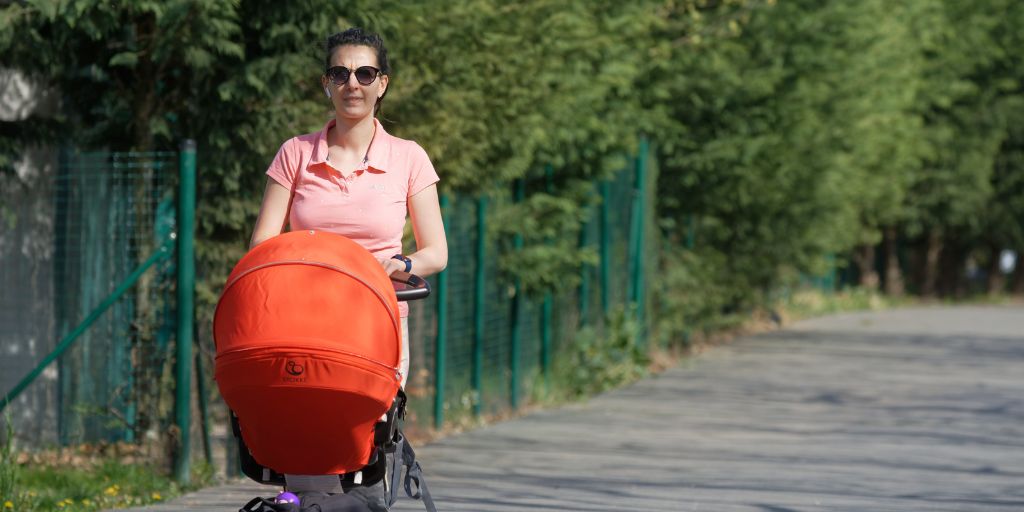We've all done it!
I did it before I invented SnoozeShade!
What is it?
Covering the pram with a muslin or cloth to shade baby from the sun or help your little one to get a much needed on-the-go nap!
A new study from University of Sydney's Heat & Health Research Incubator has found (yet again) that certain fabrics should not be used to cover prams in hot conditions.
James Smallcombe; Mohammad Fauzan Bin Maideen and Ollie Jay aimed to identify optimal low-cost stroller cooling strategies for use in hot and moderately humid summer weather. The researchers created a study to see how the heat inside a pram reacted when utilising the natural fabrics of flanellete and cotton muslin.
Unsurprisingly, muslin and flanellette were found to not be suitable to cover a pram on a hot day.
Why is this not surprising?
Because muslins and flanelette may be deemed 'breathable' but they lack a very important quality - air-permeability! They also absorb moisture so air-permeability can be reduced again as fibres swell. Nylon for example, doesn’t have these same properties. It attracts water, but there are fewer molecular opportunities for it to do so with less oxygen-hydrogen groups available. That’s why synthetic materials made without these water-absorbing tendencies are used for sportswear, where staying dry is vital.
What does breathable actually mean?
Breathability does not, as you might think, relate to an exchange of air. Instead it is the ability of a fabric to allow moisture vapour to pass through it.
This is a word used frequently in relation to sportswear and the ability of a fabric to let sweat escape. Many fabric-based products claim to be breathable but if you were to actually hold it up to your face and try and breathe through it you would struggle to do so comfortably.
So why is air permeability more important?
Air permeability is “the velocity of an air flow passing perpendicularly through a test specimen under specified conditions of test area, pressure drop, and time” (according to BS EN ISO 9237: 1995).
All air permeable fabrics are breathable to some extent, though not all breathable fabrics are air permeable.
A totally impermeable fabric would be like the tightly woven fabric used in a hot air balloon. The balloon rises because the hot air is trying to rise and cannot escape so takes the balloon with it.
How to quickly check if something is air-permeable
The best way to quickly test if a fabric is air permeable is to pop it over your face and nose and see if you can breathe comfortably through it. If you can't then it is not letting air pass through it easily - try it with a muslin, towel or blanket and you'll see exactly what I mean. It feels harder to breathe through it and the heat of your breath is blown back at you as it can't pass through the fabric. Compare that with a SnoozeShade and you'll feel the difference immediately - you can breathe easily through it as if you didn't have anything on your face.
Science dictates that hot air will rise because gases expand as they heat up so hot air is lighter, or less dense, than cool air. So in an ideal world we want hot air to rise away from baby. If we use something like a muslin, which is not very air-permeable, then the hot air can't move up and away as quickly.
Sun protection is a non-negotiable for babies under 6 months
All doctors around the world state that babies aged under 6 months must not be exposed to direct sunlight for any reason when UV levels reach 3 or above (some parts of the world recommend a year).
To give you an idea of what this means - in the UK average UV levels in summer months are between 6-8 and in Australia the summer's average is 10-14. However, even in winter most parts of Australia have UV levels of 3. In fact, the only Australian capital cities to have have average maximum UV levels lower than 3 during the winter months are Hobart and Melbourne.
It's also important to note that fair-skinned children may even burn in levels under 3. A child's skin is delicate and it takes just FIVE sunburns in childhood to increase the risk of melanoma in later life by 80%. If it's hot enough to worry about the heat then UV levels will also be high!
The best option to keep baby safe from UV is a professionally manufactured sunshade that is made from an air-permeable synthetic mesh.
However, this is real life we are talking about and we've all had times when we've been caught short when out with baby and realised it's sunnier than we thought and yet we forgot the sunshade!
Yes I manufacture sunshades but I don't want parents so scared about overheating their babies by shading them from the sun that they think it's better to walk about with baby exposed to UV rays. Even one blistering sunburn in childhood or adolescence more than doubles your chances of developing melanoma later in life (SkinCancer.org). Getting sunburn just once every two years can triple your risk of melanoma skin cancer, compared to never being burnt (Cancer Research UK).
Firstly, I should point out that the only way the researchers used the muslin and flannelette was to completely cover the front of the pram - this is not the only (or safest) way to use it to create shade.
They also state that "All fabric drapings were secured using plastic clothes pegs, ensuring that there were no gaps present." I'm not sure in the real world a parent would do this - but good to highlight this as part of the study because it would be hard for an outside breeze to impact on the temperature as it would in real life.
The stroller used in the study was in front-facing mode but it can also be used in parent-facing mode which actually creates an opportunity to loosely drape a muslin over the hood and handles thereby creating a canopy effect which will shade little one without impacting air flow underneath.
There are also ways of arranging a muslin to provide shade over a front-facing pram without completely covering the front and it can be done so loosely leaving gaps so that air can easily flow around it rather than through it. I know I almost shouldn't be saying this as a maker of sunshades but some shade is better than none. A muslin only provides about 80% UV protection so it shouldn't be used in place of a sunshade but it is better than leaving baby exposed to UV.
The other good news about muslins, is that the researchers found that by making the muslin wet it created a cooling effect.
Conclusion:
I think it's very sensible advice to advise parents to refrain from completely covering the front of a stroller with a non air-permeable fabric eg a muslin and certainly not to attach pegs in a way that means there are no air gaps present.
If you have NO CHOICE but to use a muslin because otherwise your little one will burn, here are my tips to make using one as safe as possible:
• on a forward-facing pram - attach it very loosely with plenty of gaps - because even though it is not ideal to stop UV it will create some shade to enable to you to get baby safely home - it's better than nothing!
• on a parent-facing pram - gently drape the muslin loosely over the top of the hood and over the pram handles so there is plenty of airflow beneath the muslin and around baby - again then get baby safely home..
I hope you have found this helpful and if you have any questions please click here to get in touch.
I hope you have found this helpful and if you have any questions please click here to get in touch.




